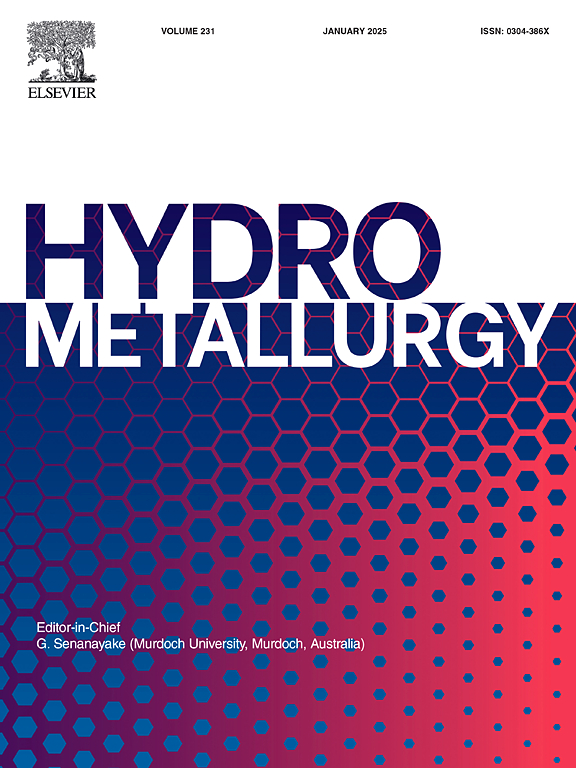Dissolution and recrystallization of alum to separate cesium, rubidium and potassium using their different precipitation kinetics to reach higher purity than solubility equilibria based purity of MAl(SO4)2 (M = Cs, Rb, K)
IF 4.8
2区 材料科学
Q1 METALLURGY & METALLURGICAL ENGINEERING
引用次数: 0
Abstract
Alum is an important intermediate for the extraction and purification of Cs or Rb chemicals, due to its excellent separation ability for Cs, Rb and K. Although the solubility sequence K-alum > Rb-alum > Cs-alum has been well known, the separation factors among Cs, Rb and K during the formation of alum have not been determined. The formation of solid solution of alum controls the Cs or Rb content and Cs/Rb/K ratio in the sequentially precipitated Cs, Rb and K alums. In this study, the thermodynamic equilibrium separation factors were determined from the solid solution-aqueous solution equilibrium data of the two mixed alum systems: (i) RbAl(SO4)2, CsAl(SO4)2, and H2O, and (ii) KAl(SO4)2, RbAl(SO4)2 and H2O. The separation factor βCs/Rb varied from 48 to 2 with the increase of the Rb/Cs ratio in system (i), and βRb/K varied from 22 to 0.2 with the increase of the K/Rb ratio in system (ii). This suggests that the purification of Cs or Rb using alums is more efficient from raw materials containing high Cs/Rb or Rb/K ratio than that from low Cs/Rb or Rb/K ratio. In kinetic studies, the apparent separation factors βCs/Rb and βRb/K were highly affected by the recrystallization process of cooling or non-cooling and the initial composition of raw alum, showing asymmetric kinetic intensification. The separation factors βCs/Rb or βRb/K obtained in the “dissolution by heating and crystallization by cooling (DHCC)” process for the raw alum with high initial Cs/Rb or Rb/K molar ratio is several times larger than the equilibrium value expected from thermodynamics. Finally, CsAl(SO4)2 and RbAl(SO4)2 with a metal-based purity of 99.97 % and 99.94 %, respectively, were obtained by using the DHCC process 3–4 times.
明矾的溶解和再结晶,利用其不同的沉淀动力学分离铯、铷和钾,获得比基于溶解度平衡的MAl(SO4)2纯度更高的纯度(M = Cs, Rb, K)
明矾对Cs、Rb和k具有优异的分离能力,是提取和纯化Cs或Rb化学物质的重要中间体。Rb-alum祝辞Cs-明矾众所周知,但明矾形成过程中Cs、Rb和K的分离因素尚未确定。明矾固溶体的形成控制着序沉淀Cs、Rb和K明矾中Cs或Rb含量和Cs/Rb/K比值。本研究利用两种混合明矾体系(i) RbAl(SO4)2、CsAl(SO4)2和H2O,以及(ii) KAl(SO4)2、RbAl(SO4)2和H2O的固-水溶液平衡数据确定了热力学平衡分离因子。随着体系中Rb/Cs比的增大(1),分离因子βCs/Rb在48 ~ 2之间变化;随着体系中K/Rb比的增大(2),分离因子βRb/K在22 ~ 0.2之间变化。说明在高Cs/Rb或Rb/K的原料中,利用明矾提纯Cs或Rb的效率高于低Cs/Rb或Rb/K的原料。在动力学研究中,表观分离因子βCs/Rb和βRb/K受冷却或非冷却再结晶过程和原明矾初始组成的影响较大,表现出不对称的动力学强化。对于初始Cs/Rb或Rb/K摩尔比高的原明矾,采用“加热溶解冷却结晶”法得到的分离因子βCs/Rb或βRb/K大于热力学平衡值的数倍。最后,通过3-4次DHCC工艺得到金属基纯度分别为99.97%和99.94%的CsAl(SO4)2和RbAl(SO4)2。
本文章由计算机程序翻译,如有差异,请以英文原文为准。
求助全文
约1分钟内获得全文
求助全文
来源期刊

Hydrometallurgy
工程技术-冶金工程
CiteScore
9.50
自引率
6.40%
发文量
144
审稿时长
3.4 months
期刊介绍:
Hydrometallurgy aims to compile studies on novel processes, process design, chemistry, modelling, control, economics and interfaces between unit operations, and to provide a forum for discussions on case histories and operational difficulties.
Topics covered include: leaching of metal values by chemical reagents or bacterial action at ambient or elevated pressures and temperatures; separation of solids from leach liquors; removal of impurities and recovery of metal values by precipitation, ion exchange, solvent extraction, gaseous reduction, cementation, electro-winning and electro-refining; pre-treatment of ores by roasting or chemical treatments such as halogenation or reduction; recycling of reagents and treatment of effluents.
 求助内容:
求助内容: 应助结果提醒方式:
应助结果提醒方式:


